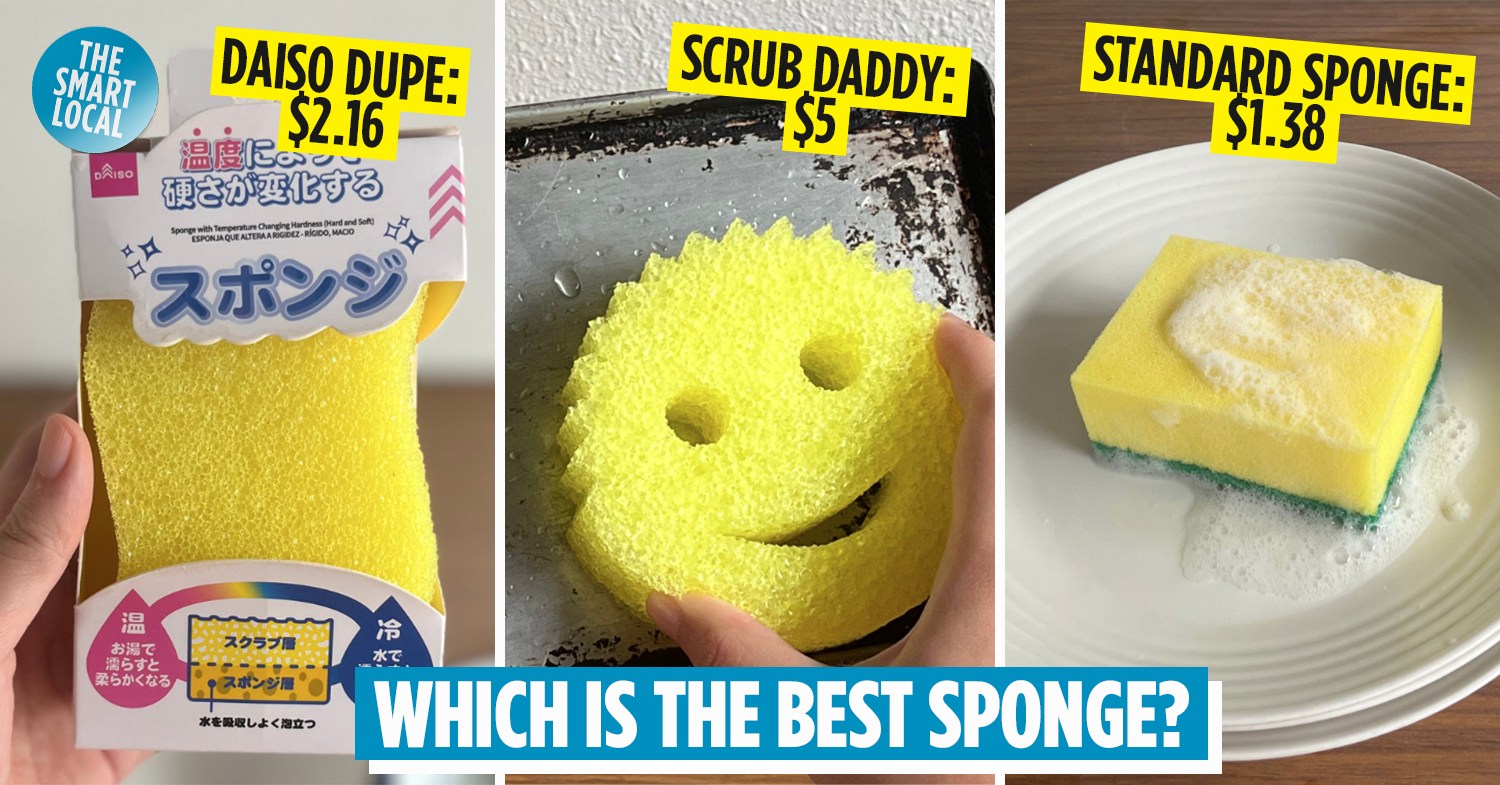Scrub Daddy in Singapore
I don’t know about you, but washing dishes is my least favourite household chore. I’m not a fan of oily messes and scraping off dried and hardened bits of food off plates, pots, and pans. Enter the Scrub Daddy.
You might already know it as the most successful pitch on the entrepreneur-investor reality TV show, Shark Tank. I know it as the dishwashing sponge that has been called “revolutionary” and “game-changing” among homemakers.
Well, the Scrub Daddy is finally available in Singapore, so now it’s time to find out if it’s really worth the hype. I’m also putting it to the test against other common household sponges to see if the Scrub Daddy can claim a spot on my kitchen sink. Here are the results:
What’s the hype about the Scrub Daddy?
On first looks, the Scrub Daddy seems like any other kitchen sponge. But technically it isn’t a sponge. Rather, it’s a polymer foam that looks like a sponge.
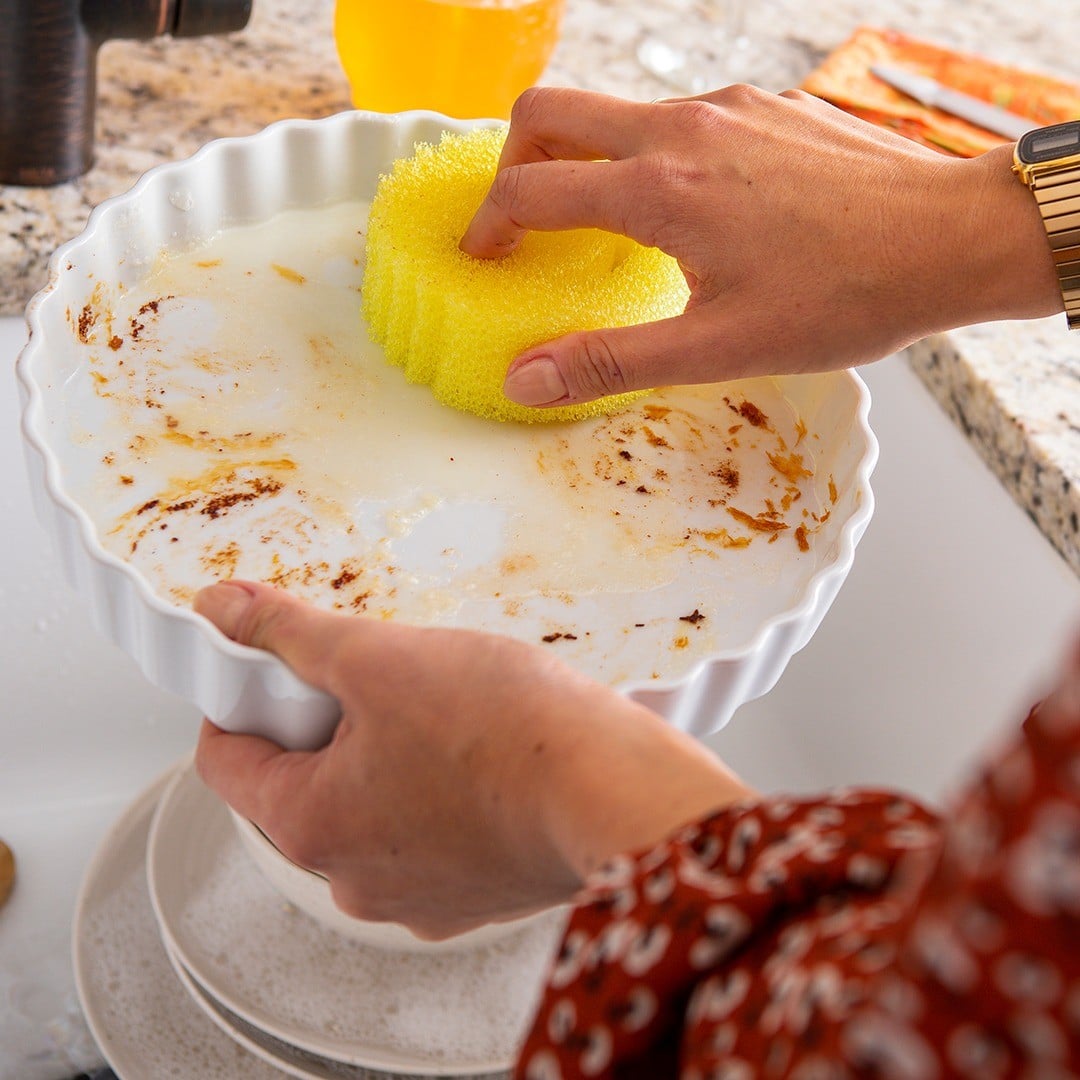
Image credit: @sklep.emarba
The major difference is when this polymer is submerged in cold water – the material hardens so it can be used for heavy duty scrubbing. Think burnt eggs on frying pans and greasy residue on the stove.
The polymer softens again when it’s submerged in warm water. This texture is best used for everyday dishwashing to rinse off food particles on ceramic, porcelain, stainless steel, non-stick surfaces, and glassware.
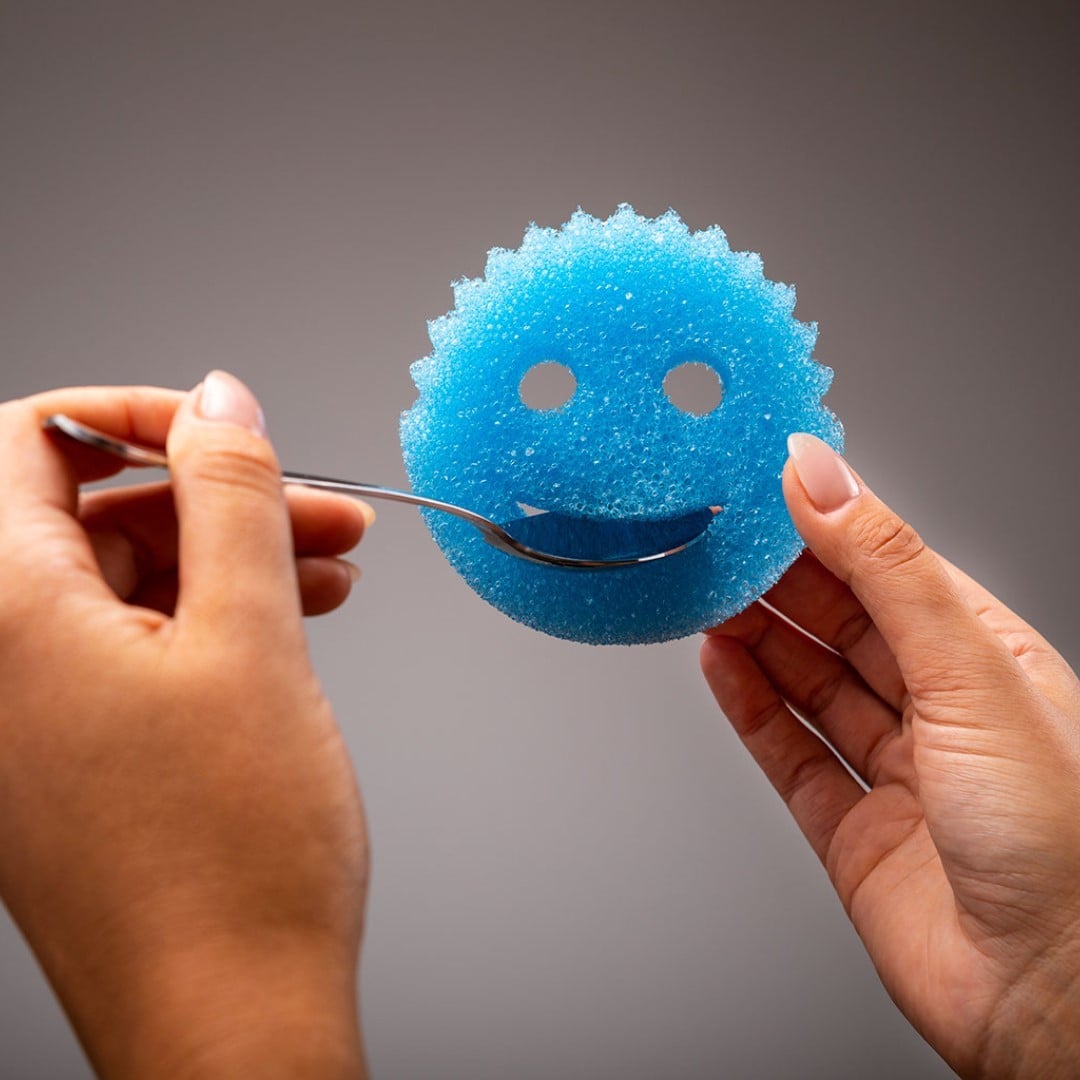
Image credit: @scrubdaddy
Another nifty feature is the smiley face. You can poke your fingers through the eyes for grip and use the smile to clean spoons, knives, and spatulas.
These unique selling points of the Scrub Daddy don’t come cheap – they’re $5 each and need to be replaced every 2 months. That’s $30 for a year’s supply. You can get one online on Shopee, Lazada RedMart, and NTUC FairPrice. They’re also available at certain supermarkets and grocery stores like Sheng Siong and NTUC FairPrice.
Testing out the Scrub Daddy
The Scrub Daddy makes a lot of claims on what it can do in the kitchen, so I wanted to put it to an extensive test of 4 common dishwashing scenarios: burnt food on a pan, oily plastic containers, a stained baking tray, and mugs stained by tea and coffee.
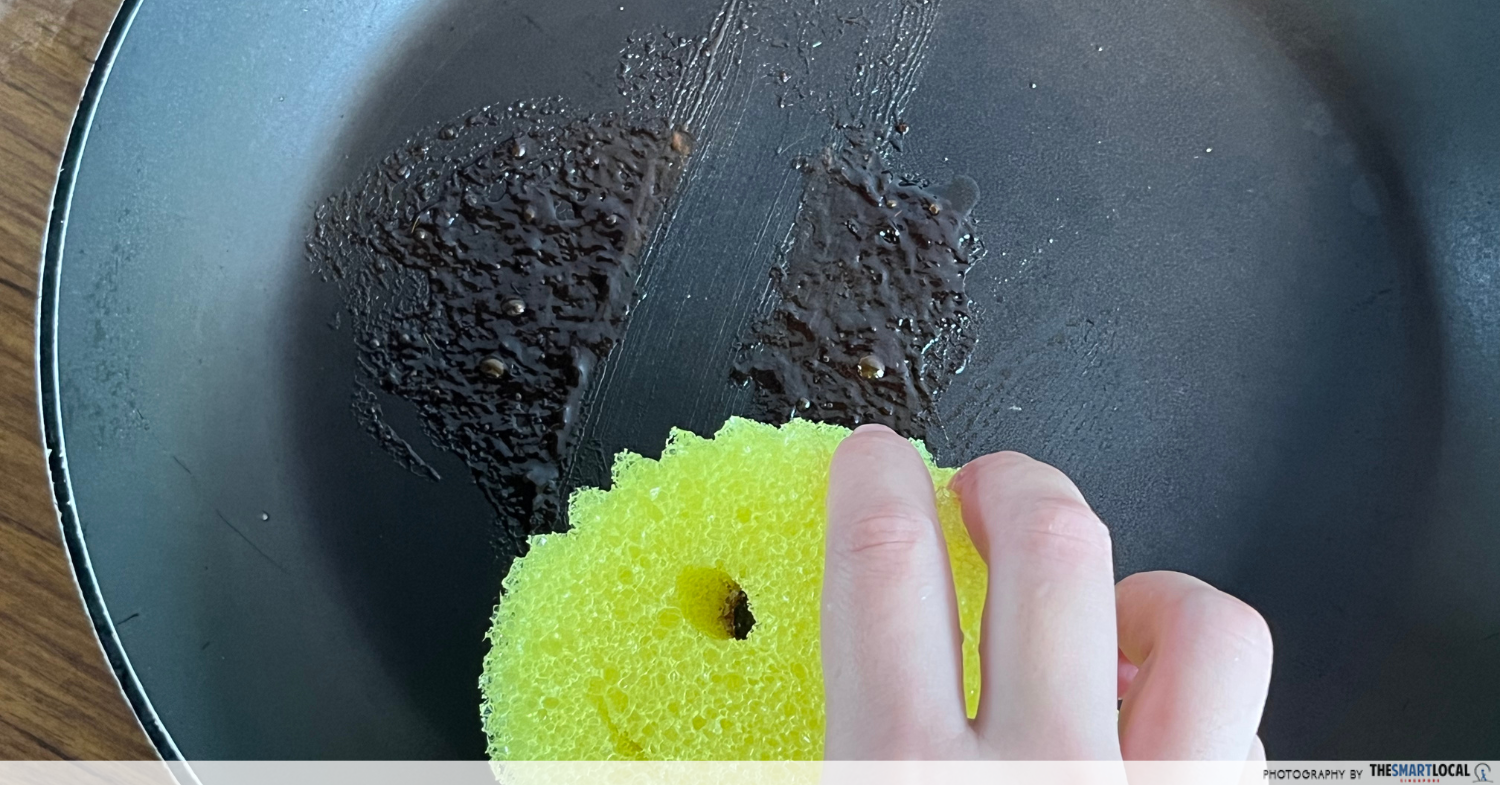
Burnt sauce was no match for the Scrub Daddy.
In these 4 tests, the Scrub Daddy performed well in 2 of them. Burnt food was easily scrubbed away and just a couple of swishes of the Scrub Daddy got rid of all traces of oil in a takeaway container that once held curry.
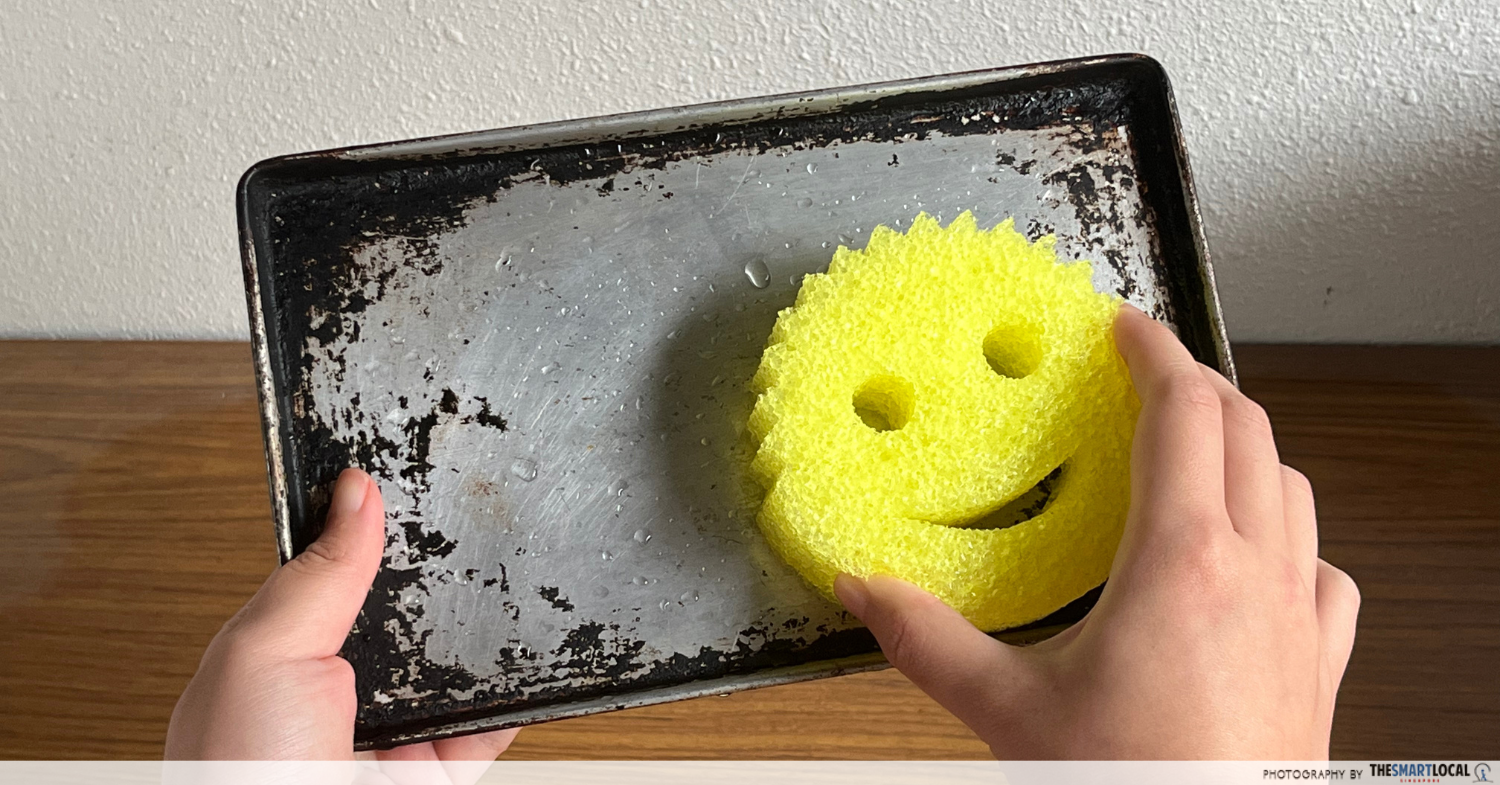
The edges of the pan remained blackened with charred bits no matter how much I scrubbed.
Where the Scrub Daddy failed was in the stained baking tray and mug, even after activating the polymer in cold water and putting in extra elbow grease. The stains that have been caked on over the years barely budged and proved too difficult to remove for the Scrub Daddy.
As for switching between textures of the Scrub Daddy, I found that you needed icy-cold water for the scrubber to really harden up enough to be used to scour off dirt and grime. But because of Singapore’s heat, the sponge would warm up quite quickly, reverting to its soft texture in a couple of minutes. I had to place a bowl of iced water nearby to keep the Scrub Daddy firm.
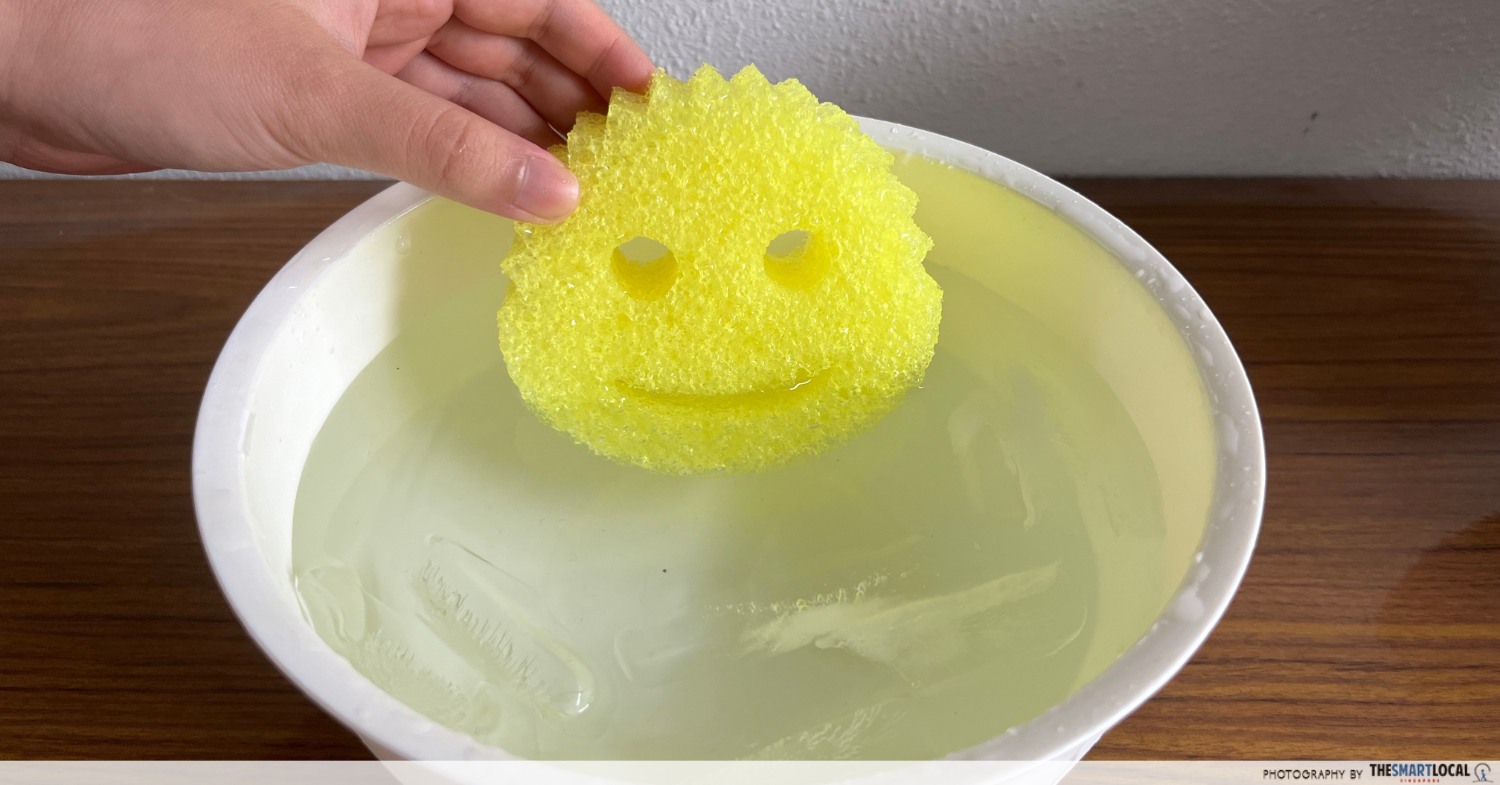
I’m not sure how many of us always have ice on standby, but if you’re keen on getting a Scrub Daddy for its scouring benefits, you might want to ensure the ice tray in the freezer has been filled before you get to work.
Thankfully, the Scrub Daddy is still effective in performance even when it’s soft. In regular cleaning, it washed away food debris on dishes. Plus, even after a week of use, the Scrub Daddy looked and felt as good as new.
Pitting the Scrub Daddy against other sponges
At $5 a piece, the Scrub Daddy is quite pricey for a dishwashing sponge. Although not a large investment, this can add up quickly if you replace it frequently. It’s recommended that the Scrub Daddy is replaced every 2 months, or when it starts to disintegrate. But some users have stated that the sponge can start to break down in 2 weeks if used on rough surfaces constantly.
With that in mind, I looked at cheaper, more common alternatives to the Scrub Daddy, such as your regular scouring sponges and steel wool to see if there were other alternatives that could hold up to the Scrub Daddy’s power.
Scouring sponge – From $1.38/piece
Walk into any kitchen and you’re more than likely to find a scouring sponge by the sink. On one side, you have a roughly-textured felt pad meant to scrub out dirt. On the other, the sponge is meant to hold dish soap and gently wash surfaces like Teflon and glass without leaving scratches.
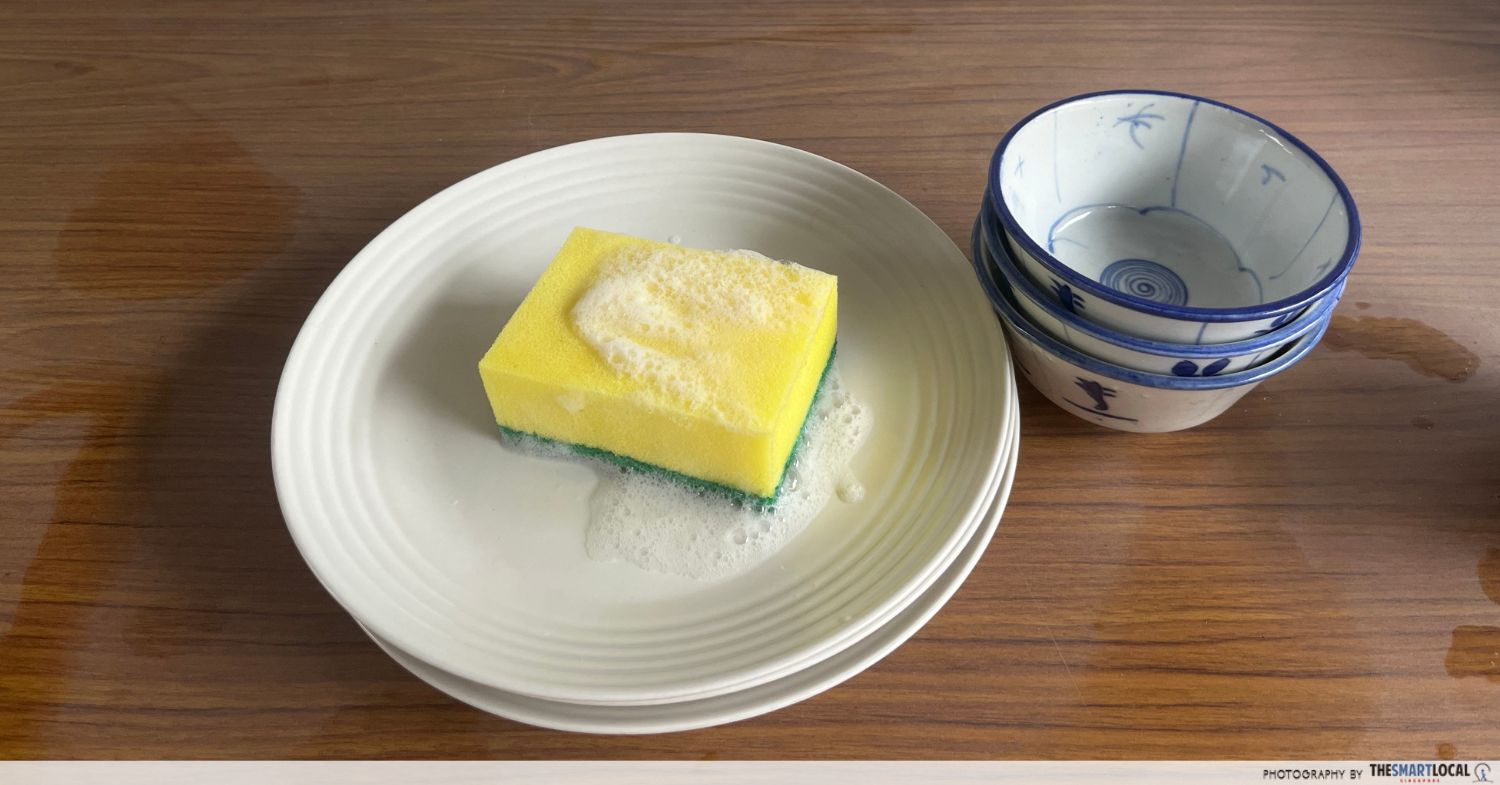
The Scotch Brite scouring sponge is my family’s choice for dishwashing. Ol’ faithful performed just as well as the Scrub Daddy when it came to getting out food burnt onto a pan. It wasn’t as effective with oily containers, but got the job done with a few more washes. The scouring pad – whether old or new – couldn’t clean the baking tray or mugs, unfortunately.
The downside to using the scouring sponge is its hygiene. They’re known to be a bacteria trap if not cleaned properly or replaced regularly. Most housekeeping guides recommend replacing it every 2 weeks, but it’s likely you’ll only replace yours when it gets really stinky and grimey after a month of use.
The Scrub Daddy, on the other hand, is quite porous, which allows water to evaporate easily and food debris to be rinsed off in a cinch. This means it’s less likely to breed bacteria, and would be a more sanitary option in the long run.
Melamine sponge – From $2.16/piece
These white blocks are marketed “Magic Erasers” for their ability to remove stubborn stains. The magic lies in the material used – melamine, which is an abrasive compound.
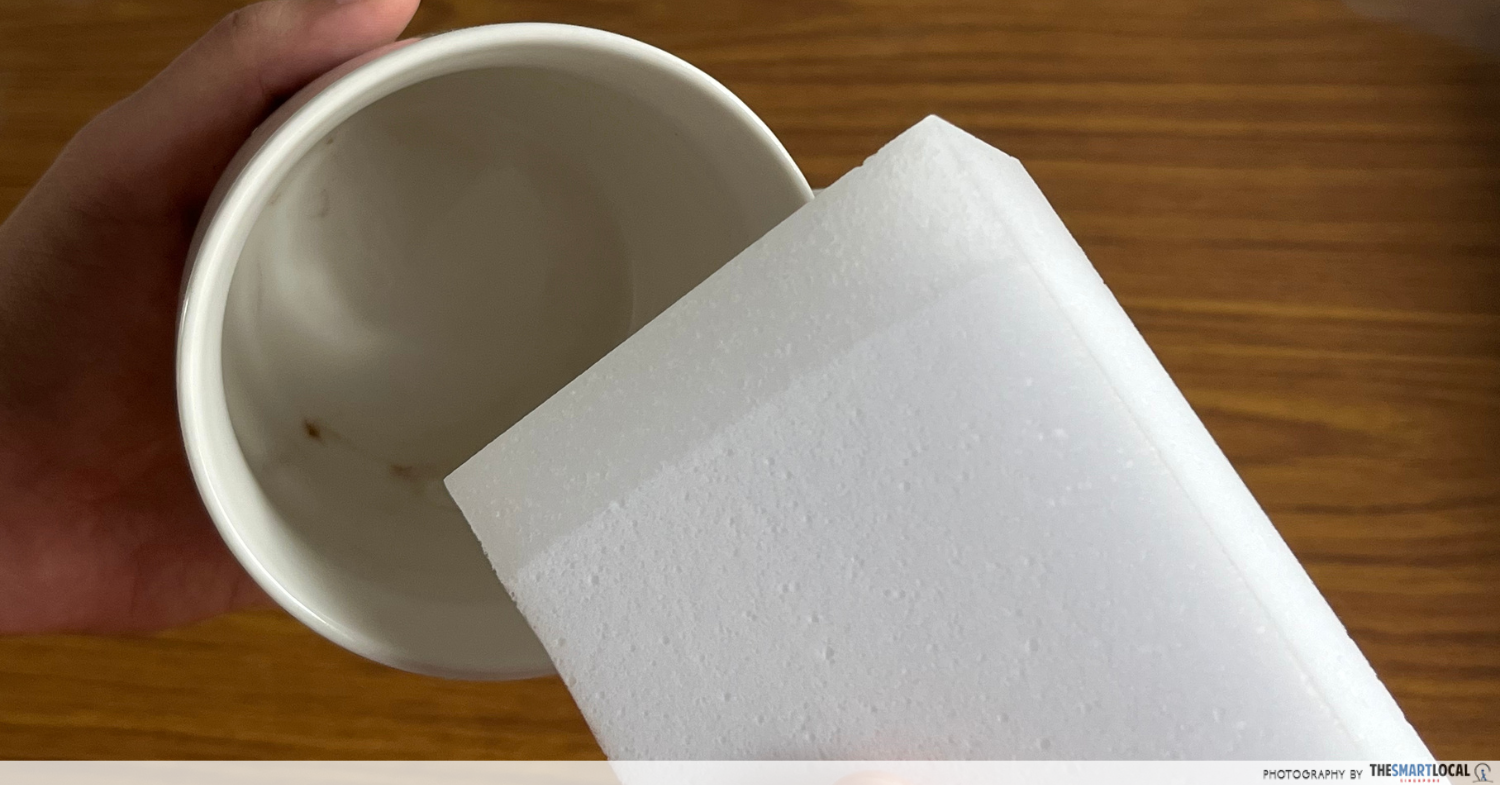
It’s not recommended to use melamine sponges for everyday dishwashing, but it does have its benefits in the kitchen. This sponge was the only one to effectively scrub out tea stains from porcelain mugs.
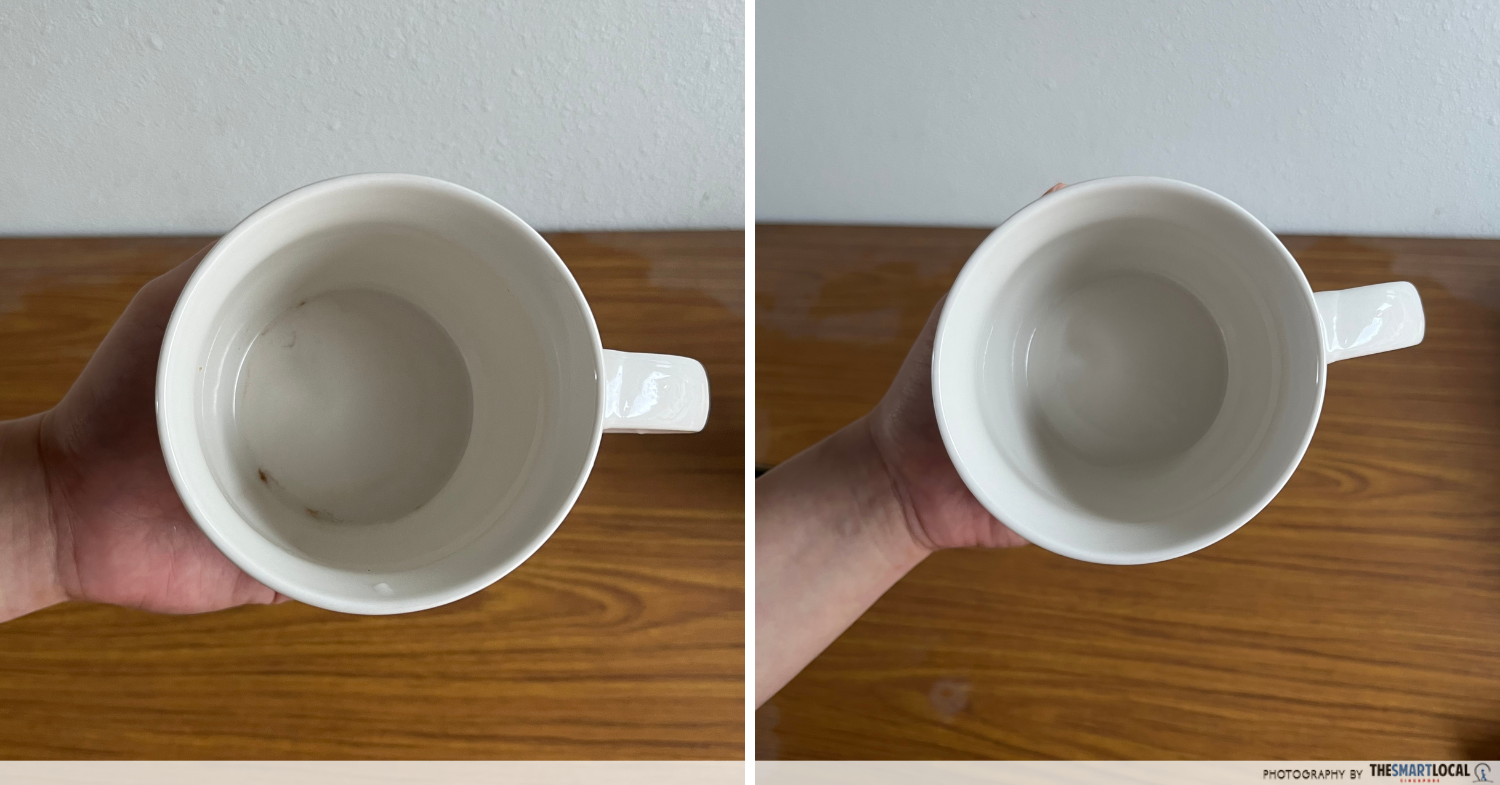
Before and after: tea stains stuck on the bottom of the cup were easily removed with the melamine sponge.
But apart from porcelain and glass, it shouldn’t be used on other dirty dishes. Due to its abrasive nature, the melamine will leave tiny scratches on stainless steel and even rub away the non-stick coating of frying pans.
Just like an eraser, the sponge breaks down with every use. It’s not significant unless you’re scrubbing out stains on the daily. You’ll only need to replace the melamine sponge when it’s used up.
Netted sponge – From $0.75/piece
If you want to maintain the surfaces of your crockery as much as possible, the netted sponge is a suitable alternative. The net that surrounds the sponge is said to be enough of a scourer during regular dishwashing. As an added benefit, it prevents food bits from being stuck in the sponge, so as to reduce bacteria growth.
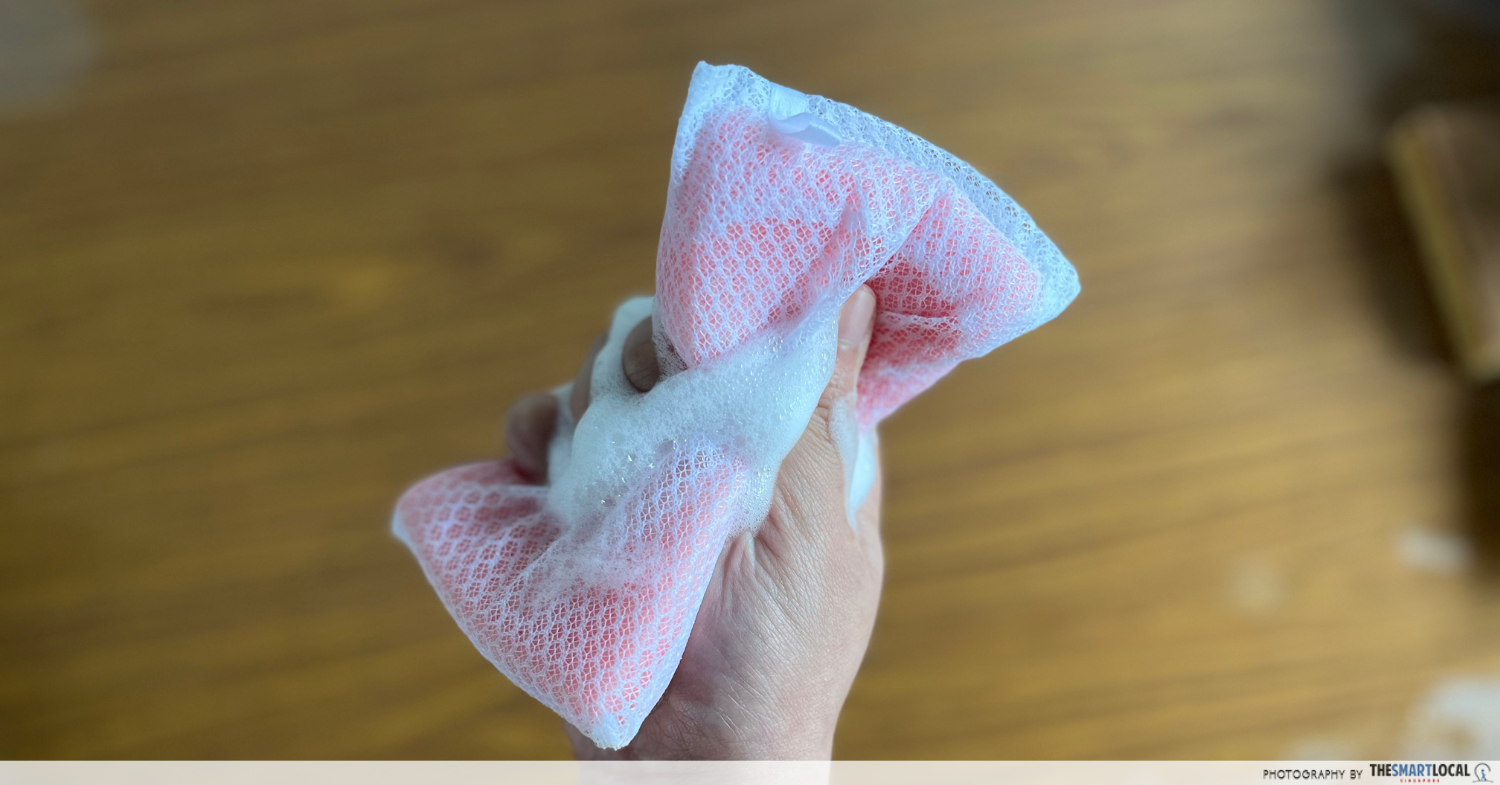
I found that the netted sponge couldn’t scour away really burnt bits on a frying pan as easily as a scouring pad or the Scrub Daddy. It also failed the baking tray and mug test. Where this dishwashing sponge really shone, however, was in degreasing plastic containers.
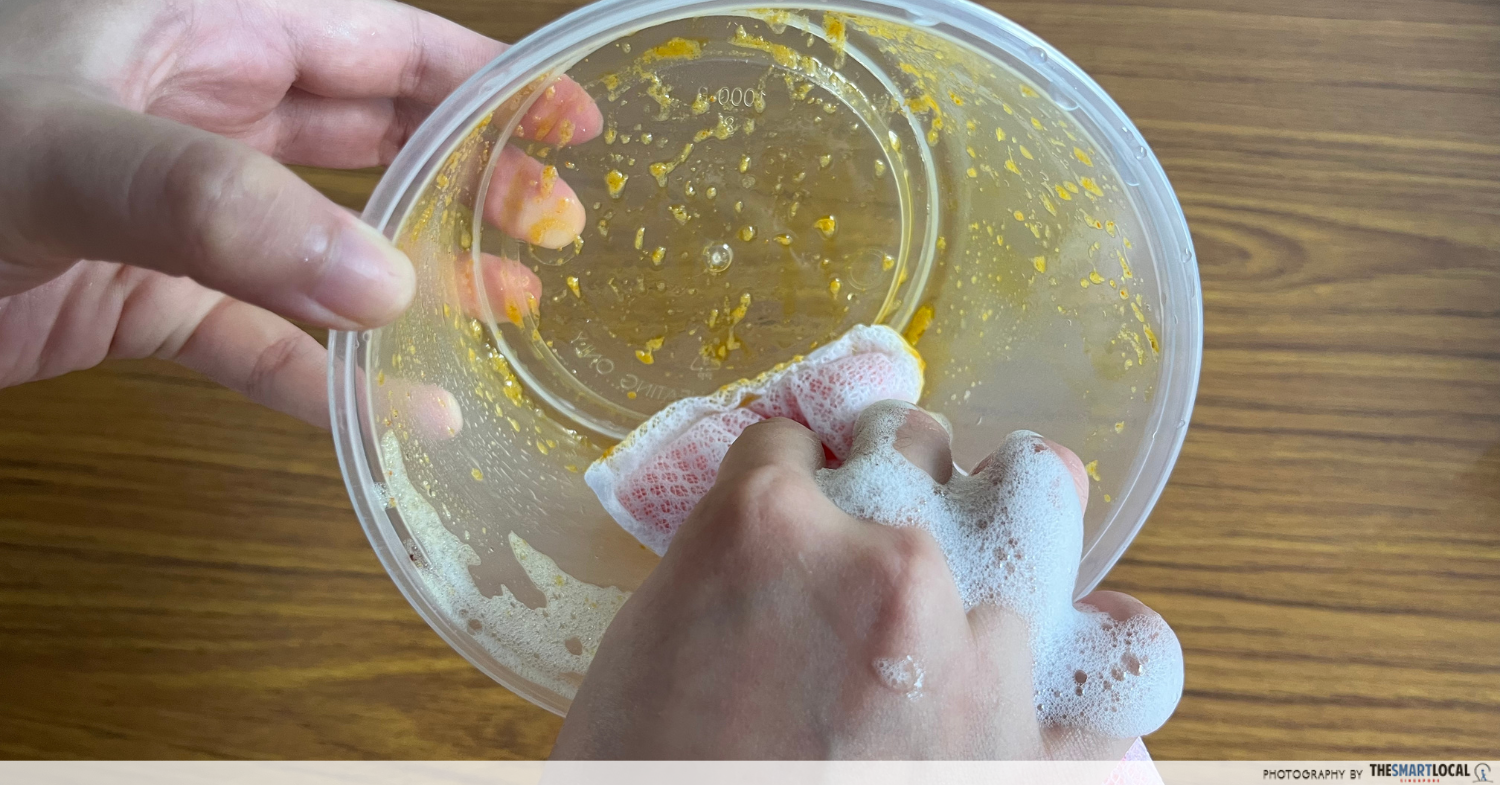
The net helped to create lots of foam with just a tiny drop of dishwashing liquid, which helped to break down the oil particles much more easily. The oily containers I tested this on were squeaky clean after a single wipe.
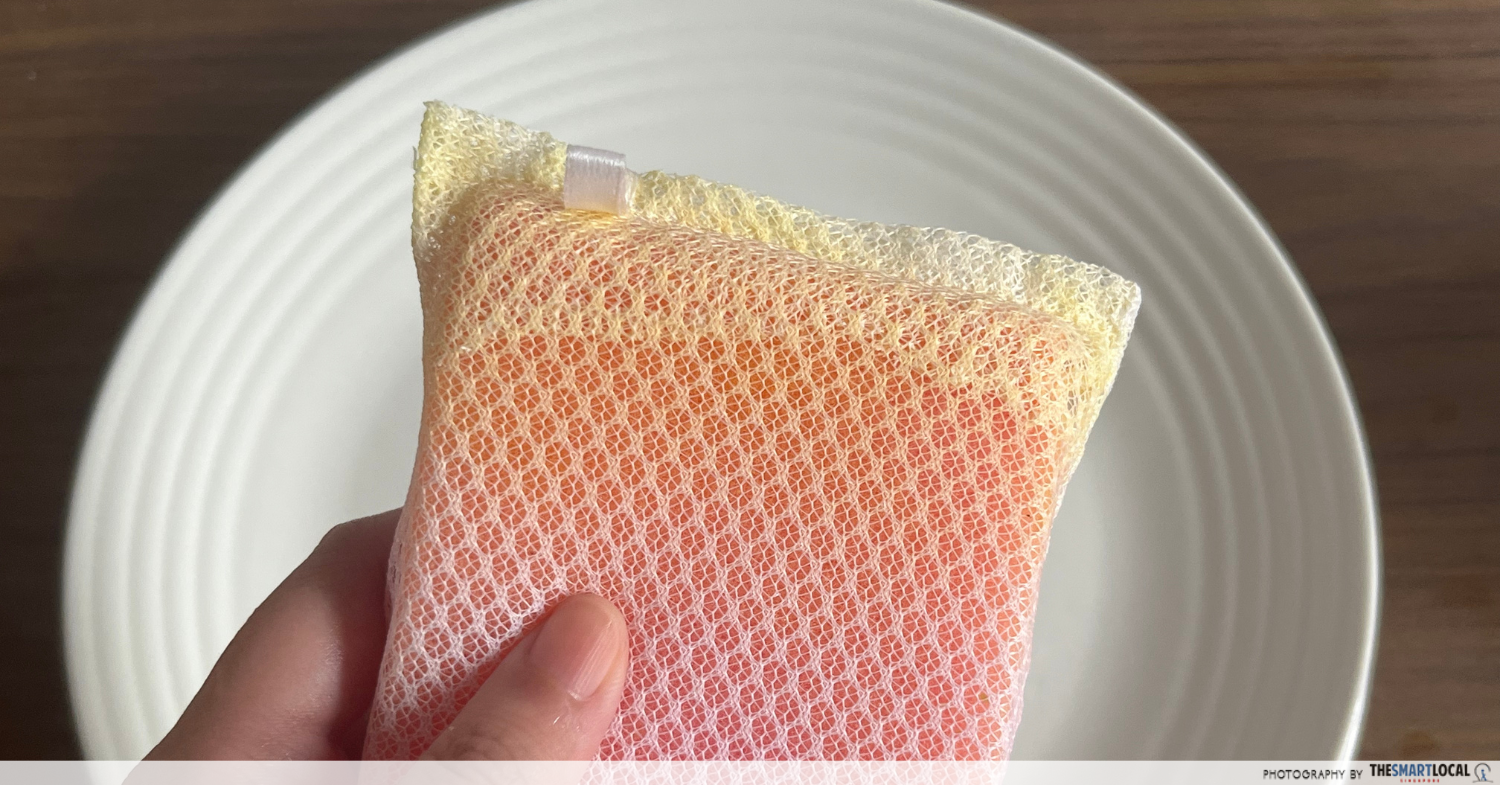
My only gripe – the netted sponge stained easily despite multiple rinses. In the long run, I don’t see the netted sponge being that much cleaner than a regular sponge.
Natural cellulose sponge – From $1.90/piece
The environmentally conscious among us would probably advocate for the use of natural cellulose sponges at home. These are often made of recycled wood pulp and are biodegradable as well.
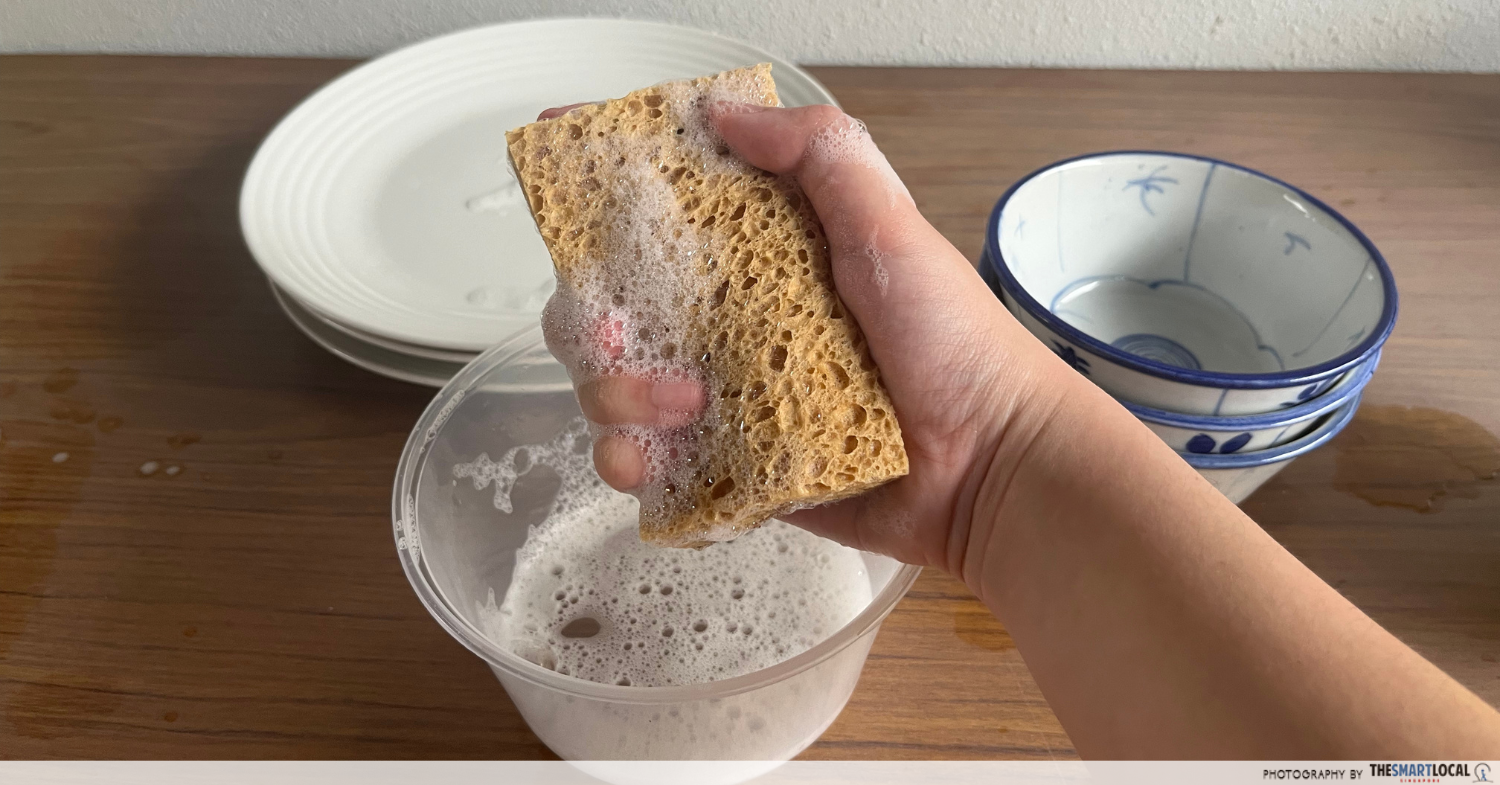
As a sponge, this performed just as well as the scouring sponge and netted sponge. The Arix WeLikeGreen Heavy Duty Cellulose Sponge came with a scouring pad attached to it, so it could scrub out grime on dishes as well.
Aside from being a greener alternative, the natural cellulose material dried quicker than the other dishwashing sponges on this list. This would probably mean it’ll be less of a breeding ground for bacteria, which would also mean you won’t have to replace this sponge as frequently.
Steel wool – From $0.93/piece
Back when my grandmother was living on her own, steel wool was one of those kitchen cleaning tools she swore by. She rarely used sponges, instead choosing to use steel wool to scrub her porcelain dishes and heavy duty carbon steel pots and pans.
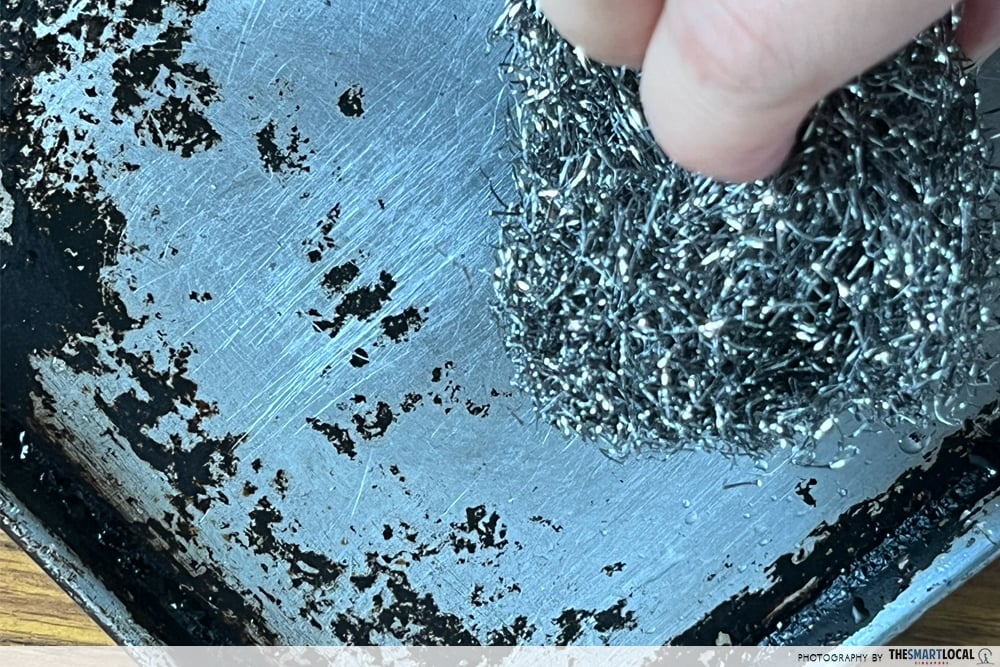
Scratches left behind from the steel wool on the baking tray.
Following in her footsteps, I used steel wool when washing my dishes. This worked well on porcelain as expected, but then my mistake came when trying to scrub a stainless steel baking tray. While I could see flecks of dirt being chipped away, the steel wool left many micro scratches on the tray. There were also scratches left behind on plastic containers as well.
If you foresee yourself only using porcelain and carbon steel in the kitchen, steel wool is a worthy investment. The piece I was using is a hand-me-down from my grandma and practically a family heirloom at this point. Based on timelines, we figured the steel wool was at least a decade old by now. This is one product you’re unlikely to repeatedly purchase over a lifetime.
Coconut husk brush – From $1/piece
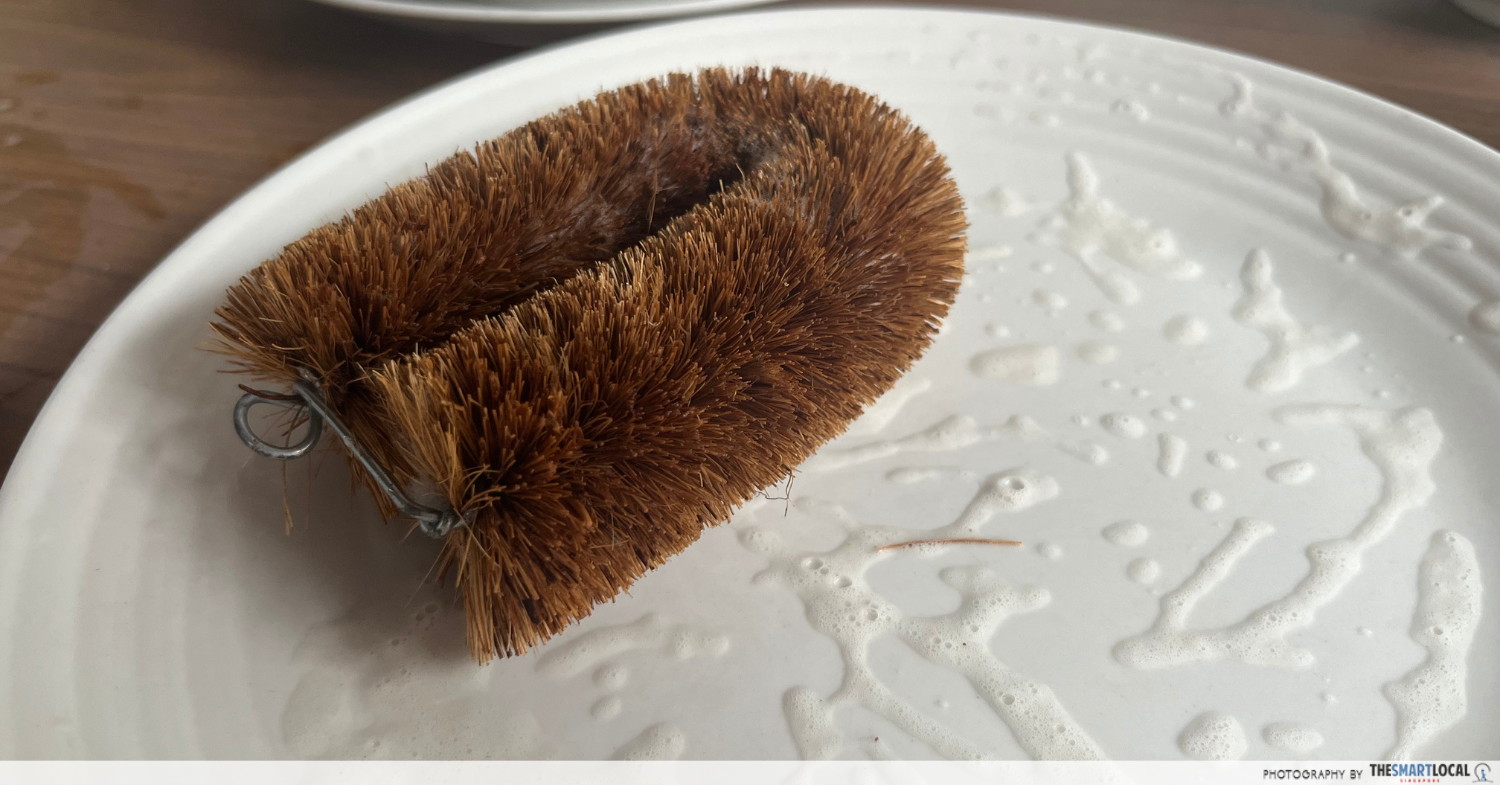
TBH, I wouldn’t have thought to use a coconut husk brush specifically for dishwashing, but multiple supermarkets listed these brushes in the same category as other sponges. The bristles of the brush are made of coconut husk fibres and said to be able to scrub off grime and oil with ease.
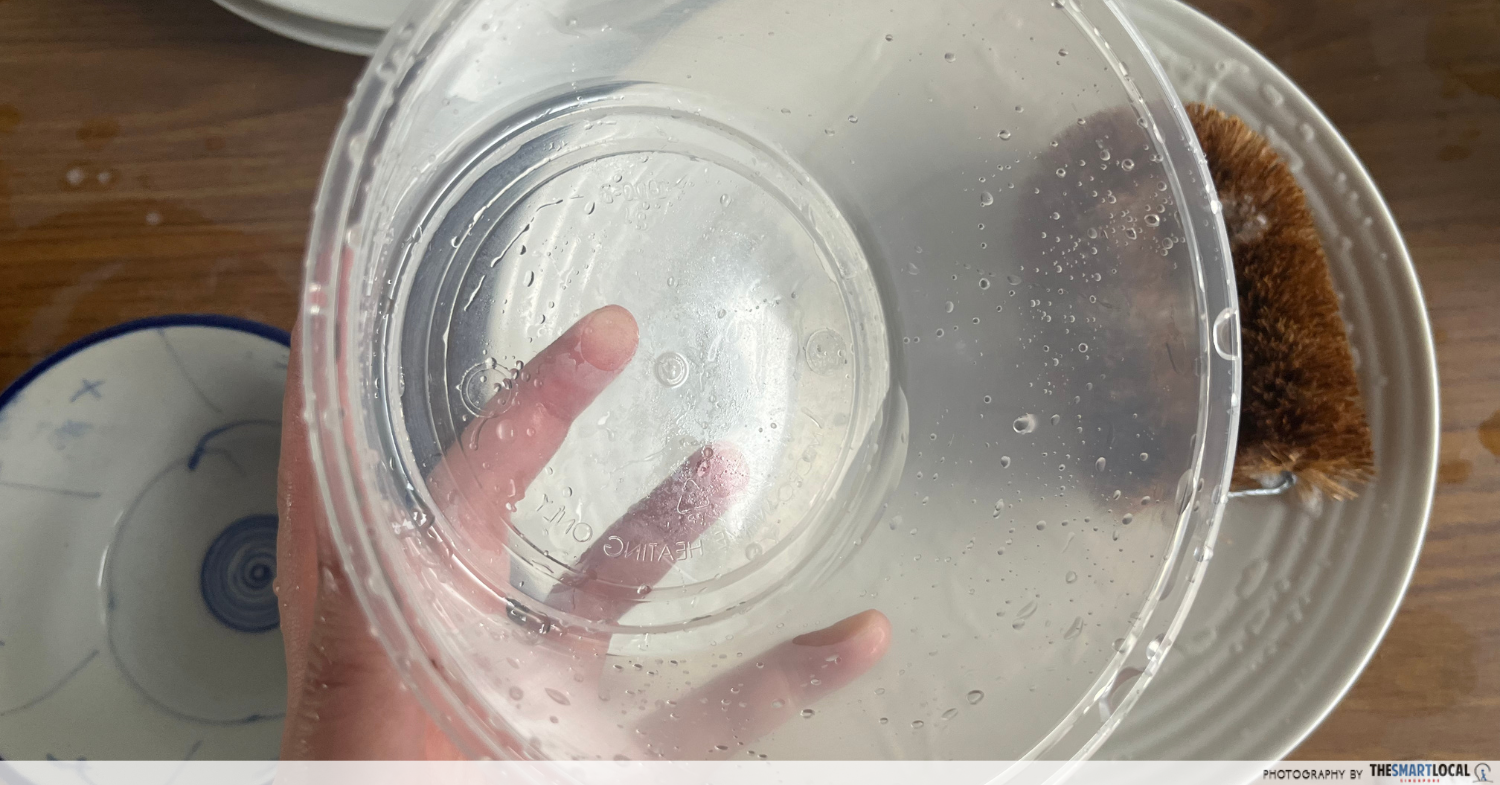
Look closely and you’ll see that the plastic container is still oily after scrubbing.
Some user error might have been involved, but this barely worked for me. My porcelain plates didn’t feel as squeaky clean as I would’ve liked. And no matter how much I scrubbed, my plastic containers were left with an oily film. Every time I put in elbow grease, the bristles would start falling off as well. Needless to say, this one was a complete fail.
Bonus: Daiso Sponge With Temperature Changing Hardness – $2.16/piece
Originally, this article was going to compare the Scrub Daddy to dupes on the market, but these were practically non-existent. The closest substitute we could find was the Sponge With Temperature Changing Hardness from Daiso.
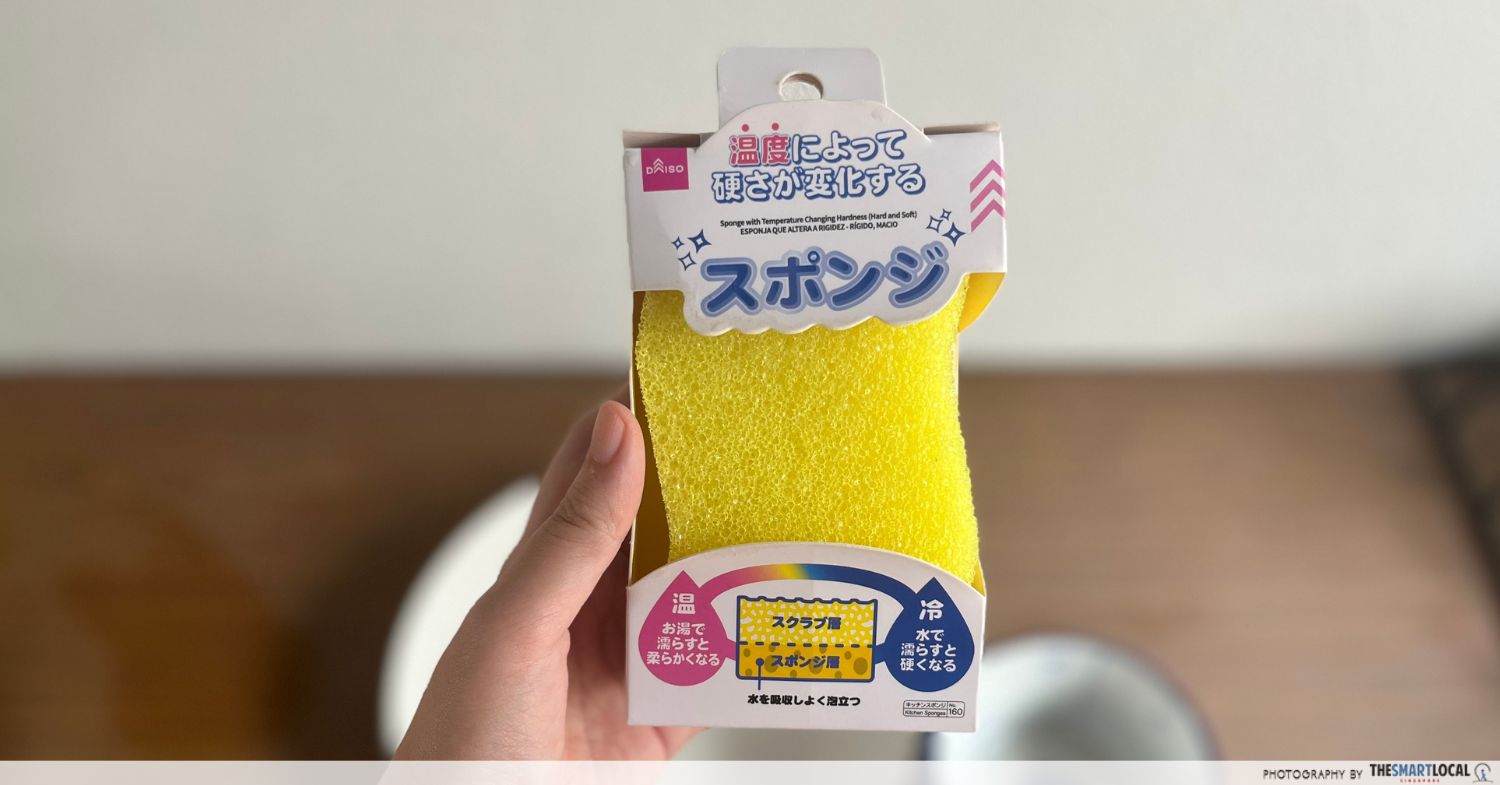
Half of the sponge is made with a similar polymer as the Scrub Daddy that also firms up in icy cold water. The other half is a regular sponge for soaping dishes. But that’s where the similarities end with this dupe.
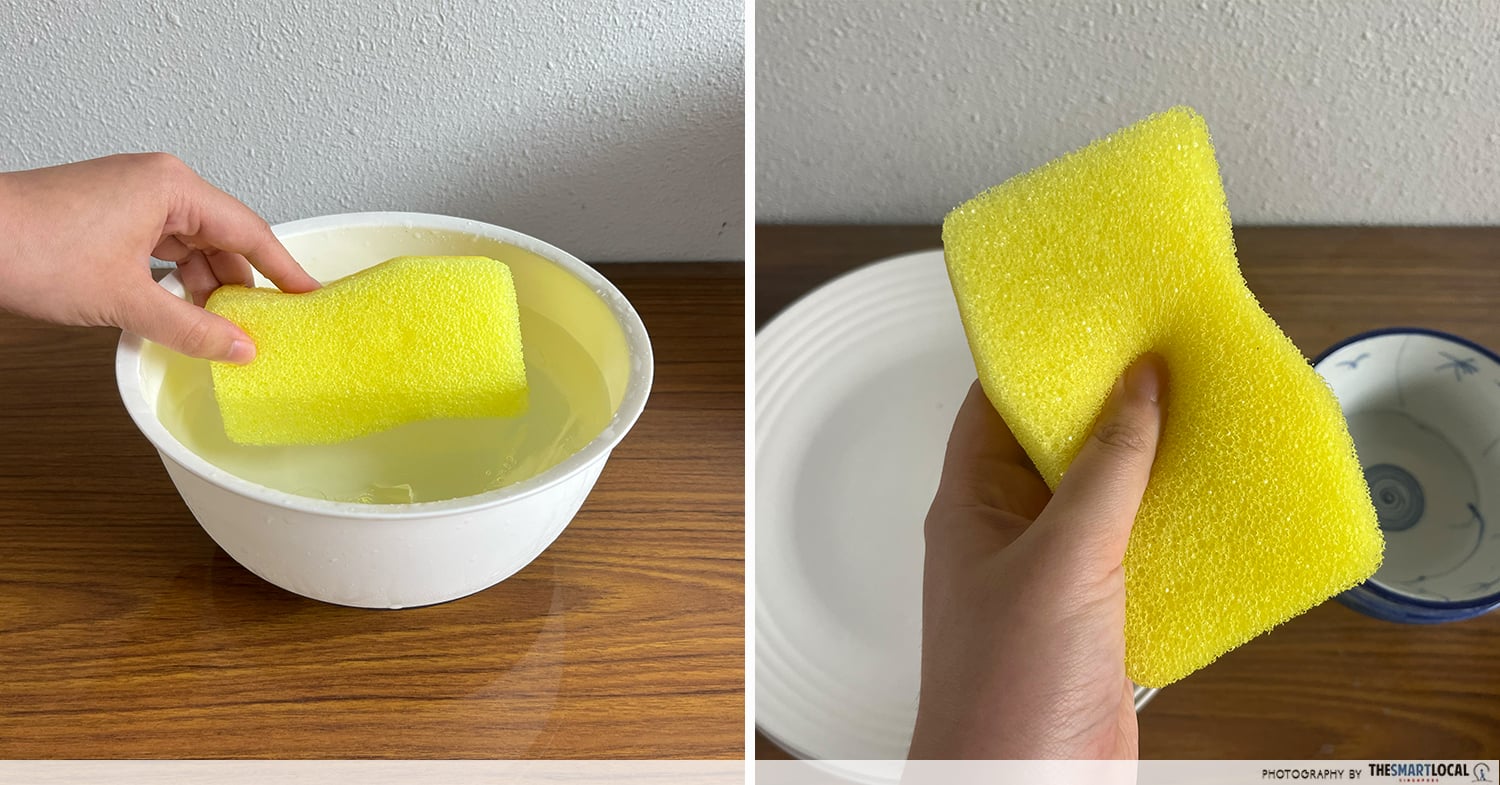
Still soft after soaking in iced water.
Unfortunately, no matter how cold I made the water, the Daiso sponge never hardened as much as the Scrub Daddy, so it didn’t have the same scouring strength as the original. Even though it remained pliable in all water temperatures, the sponge still worked effectively in washing dishes.
But at $2.16 each, I wouldn’t consider this an equal alternative to the Scrub Daddy or even a regular sponge. It’s pricier than other sponges, and durability might be an issue. Although mine looked fine after a few rounds of dishwashing, many of these sponges at Daiso seemed to already be disintegrating before use.
Is it worth getting the Scrub Daddy?
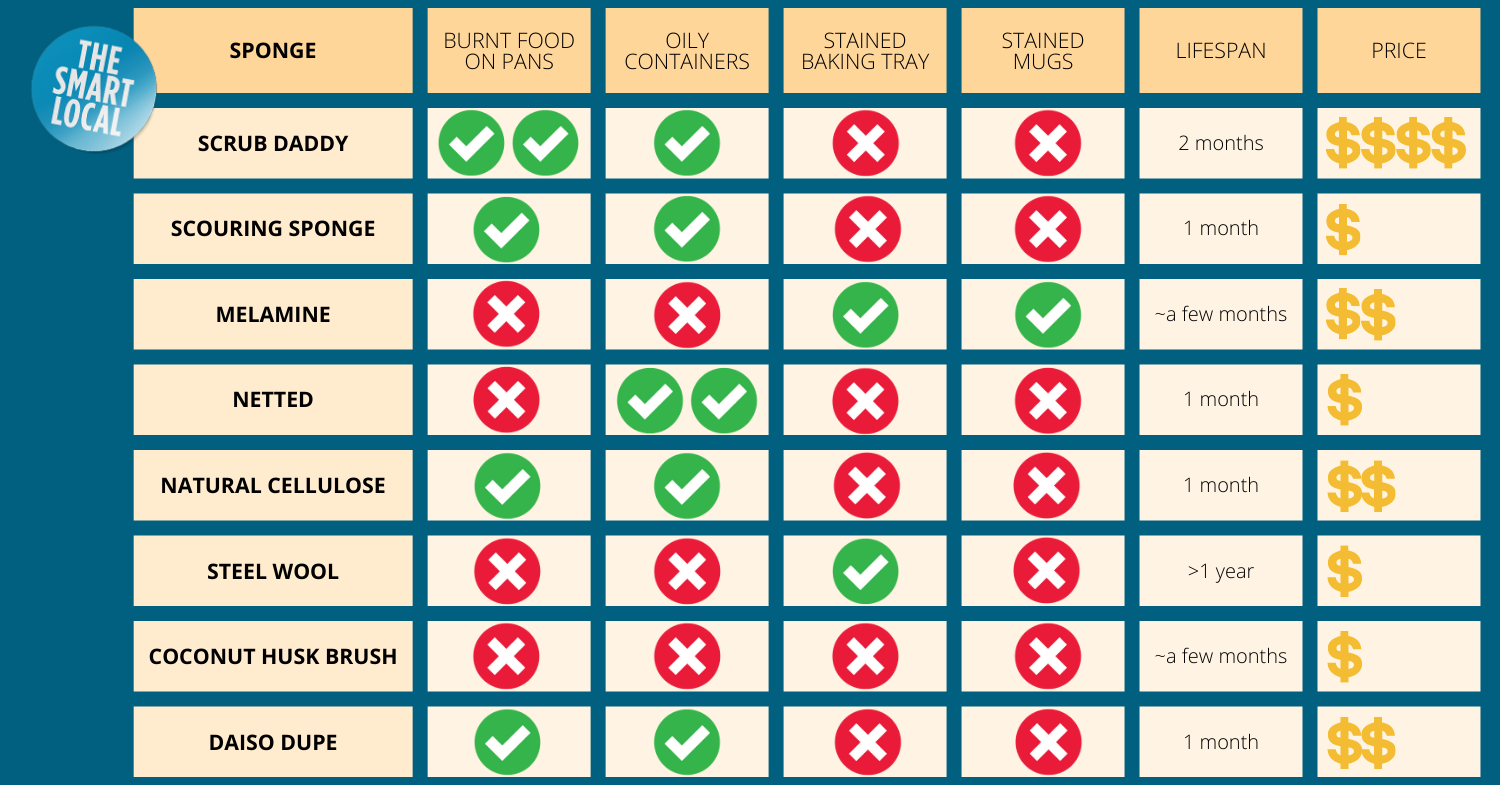
The short answer is “maybe”. The Scrub Daddy is a great tool to have as part of your arsenal of cleaning supplies for the kitchen. But, it’s not a must-have that will definitely level up your dishwashing game. While the Scrub Daddy performed exceptionally for burnt bits of food, what was troublesome was ensuring the sponge stayed icy cold just so it could scour away dirt.
I’ll continue using the Scrub Daddy until it breaks apart, but the likelihood of me replacing it isn’t high. The price is still on the steeper side and it’s not the most convenient to get as well. Since it’s only available online, there’s still the matter of having to wait for the product to be delivered before use.
Otherwise, from the tests conducted, your kitchen and dishes will do just fine with a scouring sponge and a piece of melamine for tougher stains.
Buy the Scrub Daddy here
More appliances and tools for your home:
Photography by Raewyn Koh.
Originally published on 30th January 2023.
